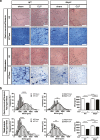Deletion of Nlrp3 protects from inflammation-induced skeletal muscle atrophy
- PMID: 28097512
- PMCID: PMC5241267
- DOI: 10.1186/s40635-016-0115-0
Deletion of Nlrp3 protects from inflammation-induced skeletal muscle atrophy
Abstract
Background: Critically ill patients develop atrophic muscle failure, which increases morbidity and mortality. Interleukin-1β (IL-1β) is activated early in sepsis. Whether IL-1β acts directly on muscle cells and whether its inhibition prevents atrophy is unknown. We aimed to investigate if IL-1β activation via the Nlrp3 inflammasome is involved in inflammation-induced atrophy.
Methods: We performed an experimental study and prospective animal trial. The effect of IL-1β on differentiated C2C12 muscle cells was investigated by analyzing gene-and-protein expression, and atrophy response. Polymicrobial sepsis was induced by cecum ligation and puncture surgery in Nlrp3 knockout and wild type mice. Skeletal muscle morphology, gene and protein expression, and atrophy markers were used to analyze the atrophy response. Immunostaining and reporter-gene assays showed that IL-1β signaling is contained and active in myocytes.
Results: Immunostaining and reporter gene assays showed that IL-1β signaling is contained and active in myocytes. IL-1β increased Il6 and atrogene gene expression resulting in myocyte atrophy. Nlrp3 knockout mice showed reduced IL-1β serum levels in sepsis. As determined by muscle morphology, organ weights, gene expression, and protein content, muscle atrophy was attenuated in septic Nlrp3 knockout mice, compared to septic wild-type mice 96 h after surgery.
Conclusions: IL-1β directly acts on myocytes to cause atrophy in sepsis. Inhibition of IL-1β activation by targeting Nlrp3 could be useful to prevent inflammation-induced muscle failure in critically ill patients.
Keywords: ICUAW; IL-1β; Muscle weakness; Sepsis.
Figures





Similar articles
-
Inhibition of the NLRP3/IL-1β axis protects against sepsis-induced cardiomyopathy.J Cachexia Sarcopenia Muscle. 2021 Dec;12(6):1653-1668. doi: 10.1002/jcsm.12763. Epub 2021 Sep 2. J Cachexia Sarcopenia Muscle. 2021. PMID: 34472725 Free PMC article.
-
Serum amyloid A1 mediates myotube atrophy via Toll-like receptors.J Cachexia Sarcopenia Muscle. 2020 Feb;11(1):103-119. doi: 10.1002/jcsm.12491. Epub 2019 Aug 23. J Cachexia Sarcopenia Muscle. 2020. PMID: 31441598 Free PMC article.
-
Targeting NAT10 protects against sepsis-induced skeletal muscle atrophy by inhibiting ROS/NLRP3.Life Sci. 2023 Oct 1;330:121948. doi: 10.1016/j.lfs.2023.121948. Epub 2023 Jul 17. Life Sci. 2023. PMID: 37467885
-
SPSB1-mediated inhibition of TGF-β receptor-II impairs myogenesis in inflammation.J Cachexia Sarcopenia Muscle. 2023 Aug;14(4):1721-1736. doi: 10.1002/jcsm.13252. Epub 2023 May 20. J Cachexia Sarcopenia Muscle. 2023. PMID: 37209006 Free PMC article.
-
Complement-induced activation of the cardiac NLRP3 inflammasome in sepsis.FASEB J. 2016 Dec;30(12):3997-4006. doi: 10.1096/fj.201600728R. Epub 2016 Aug 19. FASEB J. 2016. PMID: 27543123 Free PMC article.
Cited by
-
Sepsis induces interleukin 6, gp130/JAK2/STAT3, and muscle wasting.J Cachexia Sarcopenia Muscle. 2022 Feb;13(1):713-727. doi: 10.1002/jcsm.12867. Epub 2021 Nov 24. J Cachexia Sarcopenia Muscle. 2022. PMID: 34821076 Free PMC article.
-
Morroniside ameliorates inflammatory skeletal muscle atrophy via inhibiting canonical and non-canonical NF-κB and regulating protein synthesis/degradation.Front Pharmacol. 2022 Dec 23;13:1056460. doi: 10.3389/fphar.2022.1056460. eCollection 2022. Front Pharmacol. 2022. PMID: 36618945 Free PMC article.
-
The Stimulator of Interferon Genes Deficiency Attenuates Diabetic Myopathy Through Inhibiting NLRP3-Mediated Pyroptosis.J Cachexia Sarcopenia Muscle. 2025 Feb;16(1):e13649. doi: 10.1002/jcsm.13649. Epub 2024 Nov 27. J Cachexia Sarcopenia Muscle. 2025. PMID: 39602084 Free PMC article.
-
The NLRP3 inflammasome contributes to inflammation-induced morphological and metabolic alterations in skeletal muscle.J Cachexia Sarcopenia Muscle. 2022 Dec;13(6):3048-3061. doi: 10.1002/jcsm.13062. Epub 2022 Aug 17. J Cachexia Sarcopenia Muscle. 2022. PMID: 35978267 Free PMC article.
-
Walking down Skeletal Muscle Lane: From Inflammasome to Disease.Cells. 2021 Nov 4;10(11):3023. doi: 10.3390/cells10113023. Cells. 2021. PMID: 34831246 Free PMC article. Review.
References
-
- Bierbrauer J, Koch S, Olbricht C, Hamati J, Lodka D, Schneider J, Luther-Schröder A, Kleber C, Faust K, Wiesener S, Spies CD, Spranger J, Spuler S, Fielitz J, Weber-Carstens S. Early type II fiber atrophy in intensive care unit patients with nonexcitable muscle membrane. Crit Care Med. 2012;40:647–650. doi: 10.1097/CCM.0b013e31823295e6. - DOI - PubMed
-
- Puthucheary ZA, Rawal J, McPhail M, Connolly B, Ratnayake G, Chan P, Hopkinson NS, Phadke R, Padhke R, Dew T, Sidhu PS, Velloso C, Seymour J, Agley CC, Selby A, Limb M, Edwards LM, Smith K, Rowlerson A, Rennie MJ, Moxham J, Harridge SDR, Hart N, Montgomery HE. Acute skeletal muscle wasting in critical illness. JAMA. 2013;310:1591–1600. doi: 10.1001/jama.2013.278481. - DOI - PubMed
-
- De Jonghe B, Sharshar T, Lefaucheur J-P, Authier F-J, Durand-Zaleski I, Boussarsar M, Cerf C, Renaud E, Mesrati F, Carlet J, Raphaël J-C, Outin H, Bastuji-Garin S, Groupe de Réflexion et d’Etude des Neuromyopathies en R Paresis acquired in the intensive care unit: a prospective multicenter study. JAMA. 2002;288:2859–2867. doi: 10.1001/jama.288.22.2859. - DOI - PubMed
LinkOut - more resources
Full Text Sources
Other Literature Sources
Medical
Research Materials

